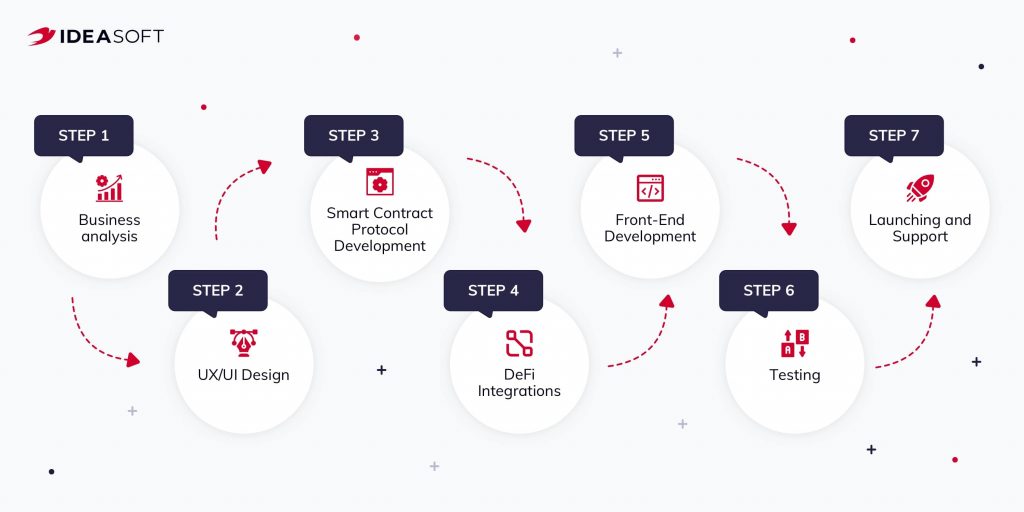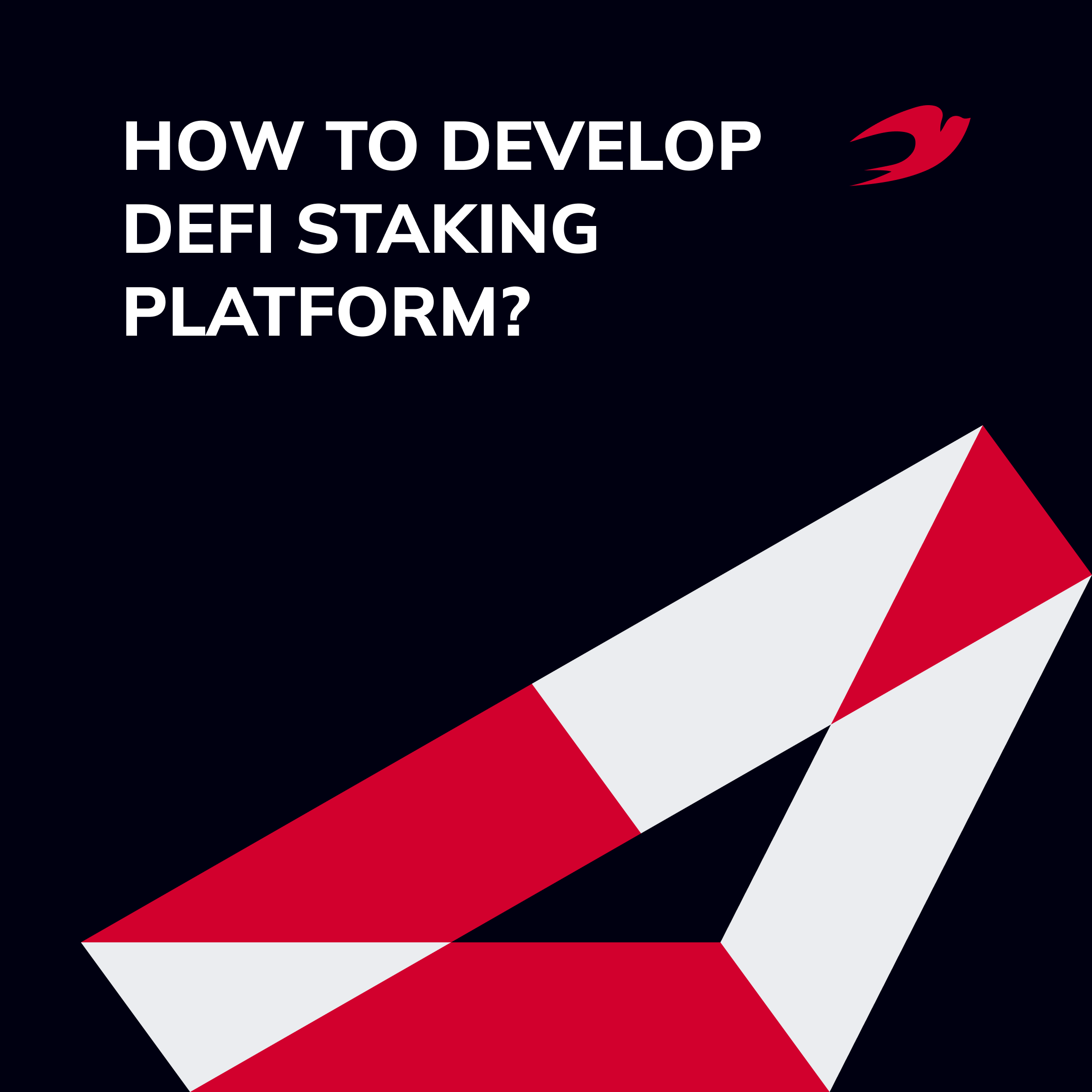Decentralized finance has opened up a host of new opportunities for members of the crypto community, including the chance to earn passive income through DeFi staking.
If you’ve also decided to take advantage of this model and are thinking about DeFi staking platform development, you’re on the right IdeaSoft blog page. In this article we will explain how DeFi staking works and more about the process of developing decentralized platforms that support this feature and what that looks like.
Table of contents:
- What is DeFi staking?
- Types of DeFi staking platforms
- Why invest in DeFi staking platform development
- DeFi staking platform features
- DeFi staking platform development process
- Wrapping up
What is DeFi staking?
Many users of centralized staking platforms have taken the opportunity to learn what DeFi staking is and how it works, and for good reason. DeFi staking is an additional way to generate income from your crypto assets by leveraging the benefits of decentralized finance.
Many developers are now aiming to develop cross-chain DeFi staking solutions, enhancing interoperability and expanding opportunities for users.
The concept of staking in a centralized and decentralized environment can be different. Before DeFi came along, staking was understood as the process of confirming transactions and generating new blocks on the blockchain and getting rewarded for doing so. DeFi staking usually works another way. You deposit your crypto assets to a DeFi protocol and receive a share of the commission from the operations performed on the platform as a reward. Thus, the DeFi protocol maintains its liquidity, and liquidity providers receive interest. You may have heard of liquidity mining or yield farming, which are basically a form of DeFi staking.
DeFi staking provides all the benefits of decentralization, such as greater transparency, fewer intermediaries, lower transaction costs, and more. Also, this method of passive earning is considered safer than traditional investments since the DeFi system is managed by self-executing smart contracts and empowered with blockchain. Additionally, utilizing a cross chain DeFi platform can enhance your staking opportunities by allowing you to leverage assets and liquidity across multiple blockchain networks.
Types of DeFi staking platforms
Since the concept of DeFi staking is fairly new, staking mechanisms differ from platform to platform. As of today, we can identify three main types of DeFi staking platforms.
Stablecoin-based DeFi Staking platforms
Such platforms have their own stablecoins, which are assets more resistant to volatility than conventional cryptocurrencies. Liquidity providers or yield farmers stake these stablecoins against crypto assets and then other users can borrow them by paying a commission to the platform. Part of this commission goes to the stakers. Compound and Aave are examples of this type of platform.
Synthetic tokens staking platforms
Some platforms such as Synthetics, allow the issuance of so-called synthetic assets that are not related to the blockchain (like gold, silver, fiat money). The platform generates a token representing a real asset and makes it available to the crypto market. Users can also place these assets in liquidity pools and receive interest.
DeFi staking aggregators
These are in fact ordinary DeFi aggregators that provide information about several liquidity pools and protocols in a single interface. They help users more intelligently allocate their assets in order to get the maximum return on investment. Zapper and Zerion are the most famous examples of DeFi aggregators.

Why invest in DeFi staking platform development
Now that we’ve discussed how DeFi staking benefits users, let’s go back to why entrepreneurs are investing in DeFi staking platform development.
So, first of all, this is a great way to attract users to your platform. The more favorable reward conditions you offer, the more likely users will contribute their assets to your platform’s liquidity pools. Hence, the more liquidity a platform provides, the more reliable it looks in the eyes of users.
Secondly, by providing staking opportunities, your platform will be able to earn more on transaction fees as there will be more transactions. That is why many lending/borrowing platforms and crypto exchanges are introducing liquidity mining and yield farming mechanisms. For businesses looking to build such platforms, crypto exchange development services can ensure a robust and secure infrastructure to support liquidity mining, yield farming, and staking functionalities.
DeFi staking platform features
The choice of features for your platform largely depends on what staking model you have chosen, what kind of opportunities you want to provide to users, and whether you plan to implement staking as a feature of a decentralized exchange or wallet or as a separate Staking-as-a-Service platform. The list below is basic. This is what you should pay attention to when choosing features for DeFi staking platform development.
User-friendly interface
Poor user experience is probably the number one problem for most DeFi platforms. Your task as a creator is to provide users with a user-friendly interface that will make it easy to navigate the site. This applies not only to the look and feel of your DeFi staking platform but also to the interface logic, information that it carries to users, and much more.
From the sign-up process to choosing assets for staking and liquidity pools, everything should be clear and should not cause complications. All relevant information should be displayed in a structured form on a dashboard. The more useful the data is that you provide to your users, the easier it will be for them to make a staking decision. For example, Aave shows a lot of chart information, including market size, total borrowing and annual interest paid on asset deposits and borrowing.

Also, one of the best ways to improve the user experience is to open up customization opportunities for users. For example, you can allow them to choose a theme for the interface or elements displayed on the dashboard.
List of supported assets and asset protection
Before embarking on DeFi staking platform development, you need to decide what assets your platform should support and what third-party protocols should integrate with.
Also, don’t forget about security. Users must be sure that the risks are minimal and they will not lose their funds due to platform vulnerabilities. The fact is that DeFi platforms are not regulated, so no one will provide refunds to users if funds are lost. Therefore, when choosing a platform for staking, security is one of the decisive factors.
First of all, you need to pay special attention to the security of wallets and smart contracts. Vulnerabilities and bugs in smart contracts are some of the most common reasons for the loss of funds on DeFi platforms. Many startups try to save money by developing software with a small team that cannot fully provide high-quality services. Building smart contracts requires deep blockchain expertise and vast experience, and since smart contracts are the protocol engine in which all the logic of work is laid, it is better to enlist the support of a skilled blockchain development team. Also, don’t forget about smart contract audits, which must be carried out by third-party developers.
Rewards calculator
The main goal of liquidity providers and investors is to make a profit, so they will probably want to know how profitable it is to use your DeFi staking platform. You need to consider the way rewards will be calculated. Some platforms have a fixed percentage, while others calculate rewards based on different market conditions.
Usually, the following factors are taken into account when calculating rewards:
- The share of coins staked by the staker and the share of coins in the network.
- The inflation rate.
- The duration of staking.
The methods for calculating rewards differ from platform to platform. The main thing is to offer users conditions that will allow you to stand out favorably from your competitors. Also, you can embed a reward calculator into the user interface so that staking users can immediately see how much compensation they will receive.
Payouts
Payouts are another important issue that users will be interested in. Define an interest payout schedule and withdrawal procedure so that platform users have a full picture of when and how they can receive their rewards, and make sure developers have clear requirements for creating algorithms. Also, don’t forget to add a transaction history report to the interface to help users track their activity.
DeFi staking platform development process
The DeFi staking platform development process fits into the standard software creation process and consists of the following stages:

- Discovery phase. This is the first step in creating any product. Here is where items are defined and clarified such as: the goals of the project, the target audience, competitors, functional and non-functional requirements, and much more. Also, the discovery phase ensures that a customer and a development team have a common vision of the project.
- UX/UI design. To ensure a high-quality user interface and create a unique UX/UI design, you need the help of experienced professionals who have worked with DeFi platforms before. We have already mentioned how important platform UX is and that this is one of the main weaknesses of decentralized apps. Take the time to create simple and straightforward navigation to help users quickly and easily perform the desired actions.
- Smart contracts protocol development. Smart contract creation is one of the most difficult steps in the DeFi staking platform development process. This is where all the logic behind how your platform functions is laid out. Weak architecture and bugs in smart contracts automatically reduce the reliability of any DeFi product. Make sure you are working with skilled blockchain developers who will provide a high level of coding.
- DeFi integrations. DeFi protocols are relatively easy to integrate with each other, however, developers need to be sure that they are compatible and the integrations will not compromise security.
- Front-End development. When the logic of the platform is created, developers begin to implement the user interface design using the frameworks that are most suitable for the project requirements.
- Testing and launching. Before releasing a product on the market, QA specialists carry out all the necessary tests to make sure that the app works as intended, is free from security vulnerabilities, and meets performance requirements. It is also good practice to conduct a smart contract audit, which should be carried out by third-party developers. During the audit, specialists check the code, identify weaknesses and optimize the protocol.
Wrapping up
There is no doubt that DeFi staking is gaining popularity with the growing interest in the decentralized finance market, and we are still far from the peak. The emergence of new staking models and improved staking platforms allows this type of passive earning on crypto assets to attract more and more investors. Not surprisingly, DeFi staking platform development is booming.
The IdeaSoft team will be happy to assist you in developing your DeFi product. Our engineers have experience in creating DEXs, NFT development solutions, lending/borrowing protocols, DeFi aggregators, staking platforms, and other blockchain-based software. The company’s portfolio includes over 250 successful projects. One of the main advantages of working with IdeaSoft is that we provide a full range of software development services: from business analysis, design to programming, testing, and support.
Feel free to contact us for more information or to discuss your project. We can’t wait to hear your business ideas.

